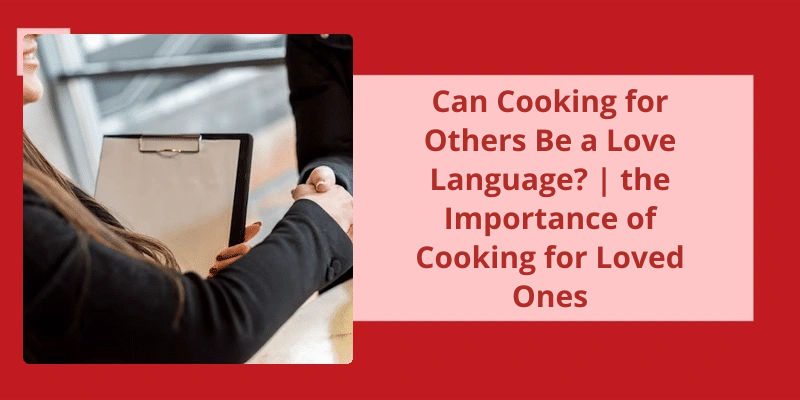Food is often considered a universal language – it brings people together, sparks joy, and evokes emotions. But can cooking for others be considered a love language? A recent study conducted among 2,000 Americans suggests that it indeed can be. According to the survey, a whopping 71% of respondents believe that cooking is their way of expressing love to those around them. Moreover, when it comes to settling down, having a partner who can cook is a top priority for two out of three respondents. These findings suggest that cooking can be a powerful tool for expressing affection and building relationships. But what exactly is the science behind cooking as a love language, and how can we harness it’s potential to strengthen our connections with others?
Can Baking Be a Love Language?
Baking can be a love language because it allows people to show their affection through their culinary skills. The time and effort spent on baking can be seen as an act of service for others, as it involves sacrificing ones time and energy to create something delicious. Moreover, working with your hands and seeing progress in the kitchen can be a physical touch that bakers enjoy, which makes it all the more special when shared with others.
Beyond the act of baking itself, sharing baked goods with others is a way of spending quality time together. It gives people a chance to gather and bond over the food that was lovingly prepared, creating memories that last a lifetime. Furthermore, the simple act of giving someone a homemade baked good can be a powerful way to express words of affirmation. Whether it’s a simple thank you or an expression of love, the gesture can speak volumes even without words.
In many cultures, baking is a traditional way of expressing love and caring for ones family and friends. Whether it’s baking a loaf of bread or preparing a batch of cookies, the act of baking and sharing is deeply ingrained in many peoples lives. It’s a way of showing love and affection that goes beyond words.
It allows people to show their affection through the art of baking and sharing, creating memories and bonding over delicious treats. So go ahead, bake and share your love with those you care for!
As we continue to explore the ever-evolving field of love languages, it’s becoming clearer that expressions of affection can take many forms. While we may already be familiar with the traditional languages of words of affirmation, acts of service, receiving gifts, quality time, and physical touch, some experts suggest that food can also be a powerful way to connect with others and show love. In fact, it’s believed that food encompasses all five senses and can tap into a deep emotional bond. So what does it mean if your love language is food? Let’s delve deeper into this intriguing topic.
What Does It Mean if Your Love Language Is Food?
If your love language is food, it could mean that you find comfort, joy, and love in sharing meals with others. Food is a universal language that brings us together, and if you value food as a symbol of love, it could mean that sharing meals with loved ones is one of the most meaningful experiences for you.
However, it’s important to note that food can also be a source of stress or anxiety for some people, so it’s not always a positive association. For example, if you struggle with disordered eating, food might not be the best way to express love or to receive love from others. It’s important to recognize your relationship with food and to seek professional help if needed.
Additionally, food can be a way to celebrate important milestones or commemorate special occasions. For example, sharing a meal together on a birthday or anniversary can be a way to show love and appreciation for the person youre celebrating with.
How Different Love Languages Can Impact a Relationship Dynamic When It Comes to Food
Love languages refer to the different ways in which people express and receive love. When it comes to food, understanding how your partner’s unique love language impacts their preferences and relationship with food can be important for maintaining a healthy dynamic. For instance, someone who shows love through acts of service may appreciate having their partner prepare meals for them, while someone who values quality time might prefer going out to eat together. By understanding and respecting each other’s love languages, you can make sure that your relationship with food continues to bring you closer together.
Cooking is more than just putting ingredients together in a dish. For some, it’s a way of expressing love and affection. When someone says “cooking is my love language,” it means that they use food as a means to show their love and care for others. It’s an act of service that not only provides nourishment but also creates an opportunity for quality time spent together. It’s a way to express creativity and share something meaningful with the people we care about. So, what does it mean to speak the language of food? Let’s explore further.
What Does Cooking Is My Love Language Mean?
When someone says that cooking is their love language, they’re essentially saying that cooking is the way in which they express love for others. This is because cooking involves a great deal of time, effort, and care, which are all key components of love. By cooking for others, someone is showing that they’re willing to put in the time and effort to create something special for them. This act of service is a powerful way to communicate love, as it shows that someone is willing to do something for another person without expecting anything in return.
In addition to being an act of service, cooking can also be a way to spend quality time with others. When someone cooks for someone else, they’re typically doing so in a shared space, such as a kitchen or dining room. This allows for conversation and connection to take place, which can be incredibly meaningful. By engaging in this quality time together, both parties are able to deepen their bonds and build trust and intimacy.
This means that when someone cooks for someone else, they’re doing so with a genuine sense of care and affection. They aren’t just slapping together a meal, but instead, they’re putting their heart and soul into what they’re creating.
All of these elements come together to make cooking one of the most meaningful ways we can express love for those closest to us.
Now that we’ve established the importance of food in expressing love, let’s delve into the different ways food can represent the love language and how you can make the most of it this Valentine’s Day.
What Love Language Is Food?
Food isn’t simply a necessity for survival, but it’s also an expression of love. Theres a reason why “Love is Cooking” among the many cookbooks out there. We prepare meals for those we care about– family, friends, and significant others. Food can be warm, comforting, and offer a sense of security. It’s the very reason why most people find solace in comfort foods. Sharing food with someone is a form of bonding, a moment of intimacy where people can enjoy each others company over a shared meal. Thats why a dinner date is the quintessential Valentines Day activity.
Food plays a significant role in strengthening relationships. In a world where people are busy, taking the time to prepare a meal for someone else is a gesture of love and sacrifice. Cooking for someone shows that youre willing to devote your time and effort to nurture that person. Studies have shown that sharing food with someone releases oxytocin, the same hormone that’s released during physical intimacy. In other words, sharing a meal with someone could elicit the same feeling you get when youre cuddling with someone.
Food also helps to foster cultural identity and traditions. Certain dishes hold sentimental value to many families, and they associate those dishes with memories of their childhood or their cultural background. Passing down recipes from generation to generation is a way of preserving family history and creating connections between past and present. Food is an excellent way to show someone that you appreciate their culture and heritage. It’s a way of embracing diversity and showing respect for others by indulging in foods that are different from your own.
Food has the power to evoke emotions. For instance, the sight or smell of a particular food might elicit fond memories and nostalgia. A dish may transport someone back to a certain time in their life, reminding them of happy memories. Similarly, sharing a meal with a loved one could create new memories that theyll cherish for years to come. Cooking for someone can be a creative expression of vulnerability, especially when it’s a dish you”ve prepared for the first time.
The Cultural Significance of Different Foods and How They Vary Around the World
- Japanese sushi and sashimi
- Mexican tacos, burritos, and tamales
- Italian pizza and pasta dishes
- Indian curries and biryanis
- Chinese stir-fries and dim sum
- American burgers and fries
- French croissants and cheese platters
- Spanish paella and tapas
- Korean kimchi and bibimbap
- Middle Eastern hummus and falafel
- Thai curries and noodle dishes
Source: Is Food the language of love? – The Catering Centre
Beyond the ingredients and techniques involved in cooking, there’s a language rooted in culinary culture that reflects the complexity and nuance of flavor combinations. This language is founded on a unique set of terms that encapsulate distinct relationships between ingredients, textures, and tastes. Known as the Cooking Language, it’s a system that employs a specific lexicon to describe these relationships. Developed around a subset of languages optimized for individual ingredients, including Egg, Onion, Tofu and other unique culinary components, this language allows chefs to communicate the nuances of their creations more effectively.
What Is the Language of Cooking?
The language of cooking is a concept that’s been developed to help chefs and cooking enthusiasts better understand the ingredients that they work with. At it’s core, this system is designed to capture the relationships that exist between ingredients, and to give these relationships unique names that can be used to describe and replicate dishes.
For example, there’s an Egg Language that’s used to describe the various ways in which eggs can be used in cooking, from scrambling to poaching to baking. There’s also an Onion Language that’s used to capture the unique properties and flavors of different types of onions, and a Tofu Language that focuses on this popular vegetarian protein.
Rather than having to rely on vague descriptions like “just a pinch of salt,” for example, the language of cooking provides specific measurements and techniques for adding salt to a dish. This makes it easier to replicate recipes and to understand the nuances of different cooking styles and methods.
Another benefit of the language of cooking is that it can help to reduce waste in the kitchen. By understanding the relationships between ingredients and how they interact with each other, chefs can create more efficient and sustainable menus that make the most of their available ingredients. This, in turn, can help to reduce food waste and increase the overall efficiency of a restaurant or home kitchen.
Conclusion
The act of nourishing someone else with a homemade meal goes beyond just fulfilling a basic need for sustenance. It shows care and affection, and can even be seen as a form of self-expression. The fact that finding a partner who can cook is a top priority for many people further emphasizes the significance of culinary skills in relationships.






